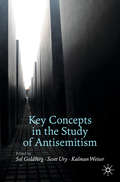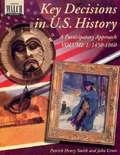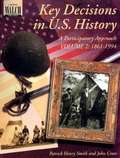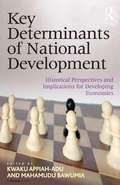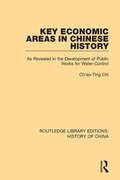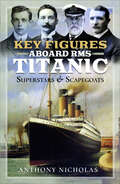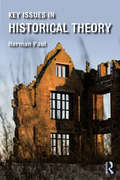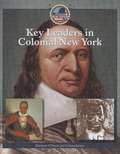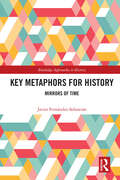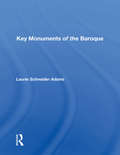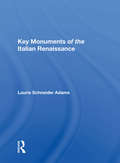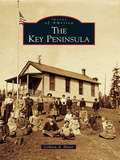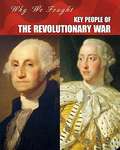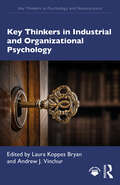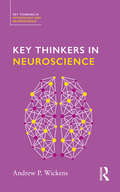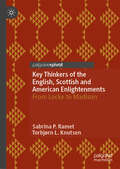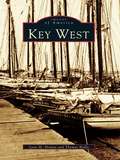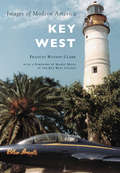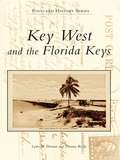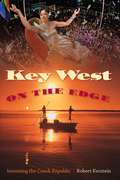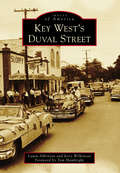- Table View
- List View
Key Concepts in the Study of Antisemitism (Palgrave Critical Studies of Antisemitism and Racism)
by Scott Ury Kalman Weiser Sol GoldbergThis volume is designed to assist university faculty and students studying and teaching about antisemitism, racism, and other forms of prejudice. In contrast with similar volumes, it is organized around specific concepts instead of chronology or geography. It promotes conversation about antisemitism across disciplinary, geographic, and thematic lines rather than privileging a single methodological paradigm, a specific academic field, or an overarching narrative. Its twenty-one chapters by leading scholars in diverse fields address the relationship to antisemitism of concepts ranging from Anti-Judaism to Zionism. Each chapter not only traces the history and major scholarly debates around a key concept; it also presents an original argument, points to avenues for further research, and exemplifies a method of investigation.
Key Decisions In U. S. History: 1450-1860
by John Croes Patrick Henry SmithPromotes critical-thinking and decision-making skills through comprehension activities. Focuses on key decisions and provides background to fuel informed discussion.
Key Decisions In U. S. History: A Participatory Approach (Vol. 2 -- 1861-1994)
by John Croes Patrick Henry SmithPromotes critical-thinking and decision-making skills through comprehension activities Focuses on key decisions and provides background to fuel informed discussion.
Key Determinants of National Development: Historical Perspectives and Implications for Developing Economies
by Kwaku Appiah-Adu Mahamudu BawumiaFor those wishing to acquire knowledge on national development issues, this comprehensive compendium traverses a spectrum of subjects that the audience ought to be well acquainted with. The Editors provide instructive findings regarding national development, economic growth and their determinants, but they also offer historical perspectives on the subject and the implications for developing countries. The book addresses a suite of critical themes regarded by development experts to be germane in considering the pertinence of policies and their effective execution. These seven general thematic areas are explored: ¢ Leadership, governance, policy and strategy ¢ Public sector and public financial management ¢ Culture, institutions and people ¢ Natural resources ¢ Science, technology and infrastructure ¢ Private sector and financial markets ¢ Marketing, branding and service delivery This thematic approach enables the contributors to explore the impact of the constituents of each subject area on national development, within the context of a developing economy. The significance of the findings for the relevant stakeholders is consequently reviewed. The combination of theory and practice makes the book and its contents unique.
Key Economic Areas in Chinese History: As Revealed in the Development of Public Works for Water-Control (Routledge Library Editions: History of China #10)
by Ch'ao-Ting ChiThis book, first published in 1936, offers the conception of the dynamics of the Key Economic Area as an aid to the understanding of Chinese economic history. By tracing their development through a historical study of the construction of irrigation and flood-control works and transport canals, it shows the function of the Key Economic Area as an instrument of control of subordinate areas.
Key Figures Aboard RMS Titanic: Superstars & Scapegoats
by Anthony NicholasTitanic. The Marilyn Monroe of ocean liners. A sleek, sultry beauty, taken out way before her time. A kind of 21st century Flying Dutchman, with interiors by Cesar Ritz, still striving to achieve the waters of a port she can never reach. Fuelled by a subtle mixture of horror, fascination and sheer, fatal glamour, she surges heedlessly across the still, starlit calm of our collective subconscious, hell bent on achieving her chilling, near midnight rendezvous with her killer. Titanic is a brilliantly lit stage, carrying her cast of exotic, terminally endangered extras toward an abyss at once both unfathomable and inconceivable. Here’s where any similarity with any other tome about the Titanic ends. For the first time ever, a succession of key characters and groups of individuals come to the fore. Centre stage, over seventeen chapters, we meet the men whose decisions, actions and omissions combined like some slow burning powder trail to trigger a final, cataclysmic conclusion; the foundering, in mid Atlantic, of the biggest moving object ever seen on the face of the planet. One by one, a series of individuals take a bow. Seemingly omnipotent owners and hugely experienced ship’s officers. Engineers and designers. Would be rescuers and embattled wireless operators. We meet them as individuals, not supermen. Their histories, backgrounds and life experiences are assessed for the first time ever, putting their actions on the night that Titanic sank into a context, a light as stark as that of the distress rockets, arcing into the sky…
Key Issues in Historical Theory
by Herman PaulKey Issues in Historical Theory is a fresh, clear and well-grounded introduction to this vibrant field of inquiry, incorporating many examples from novels, paintings, music, and political debates. The book expertly engages the reader in discussions of what history is, how people relate to the past and how they are formed by the past. Over 11 thematically-based chapters, Herman Paul discusses subjects such as: history, memory and trauma historical experience and narrative moral and political dimensions of history historical reasoning and explanation truth, plausibility and objectivity. Key Issues in Historical Theory convincingly shows that historical theory is not limited to reflection on professional historical studies, but offers valuable tools for understanding autobiographical writing, cultural heritage and political controversies about the past. With textboxes providing additional focus on a range of key topics, this is an attractive, accessible and up-to-date guide to the field of historical theory.
Key Leaders in Colonial New York (Spotlight on New York)
by Colleen Adams Elizabeth O'GradyNew York would not be the state it is today without the many strong leaders of its past. This fascinating resource examines some of the most influential men and women in New York s early history, including Peter Minuit, Sybil Ludington, Peter Stuyvesant, Red Jacket, and George Clinton. Entertaining biographical information is woven into the narrative of New York history and is presented along with primary source documents and paintings supporting the contributions of these early luminaries.
Key Metaphors for History: Mirrors of Time (ISSN)
by Javier Fernández-SebastiánThis book casts a fresh look at what to date has been a relatively unexplored question: the enormous value and usefulness of the metaphor in the understanding and writing of history (and at the historical culture reflected by these metaphors). Mapping a wide range of tropes present in historiography and public discourse, the book identifies some of the key metaphorical resources employed by historians, politicians, and journalists to represent time, history, memory, the past, the present, and the future and examines a selection of analytical concepts of a temporal nature, built upon unmistakeably metaphorical foundations, such as modernity, event, process, revolution, crisis, progress, decline, or transition.The analysis of these and other pillars on which modern history has been built, whether as a philosophy of history, as an academic discipline, or as a set of events, will interest graduates and scholars dealing with the historical and social sciences and the humanities in general.Key Metaphors for History offers a broad overview of historiography and historiosophy, from an unfrequented point of view, halfway between conceptual history, theory of history and metaphorology. Moreover, it constitutes a form of self-reflection of the historian on his or her own positionality when researching and writing history.
Key Monuments Of The Baroque
by Laurie Schneider AdamsThis book focuses on key monuments of the Baroque style, which varies in different European contexts. It is intended to affirm the existence of individual genius, identifiable styles of art, and historical periods that produced them.
Key Monuments Of The Italian Renaissance
by Laurie Schneider AdamsOrganized chronologically from early Renaissance precursors to the Mannerist movement, from Giotto to Titian, Key Monuments of the Italian Renaissance describes and analyzes in depth from various points of view major works and major artists, from the fourteenth to the sixteenth centuries. Artists included are Cimabue, Duccio, Giotto, Lorenzetti, Gh
Key Peninsula, The
by Collen SlaterThe Key Peninsula is a scenic finger of land that stretches south between Case and Carr Inlets in Washington State. Few people lived there before 1850, although Native Americans fished and hunted from temporary villages. Several communities, each with a unique history, took root near the various bays and inlets of the peninsula, and by the 1890s, many areas bustled with schools, post offices, mills, churches, and stores. Logging, orchards, and chicken farms supported these early pioneers. Cut off from the mainland, the waters of Puget Sound provided transportation. The famous Mosquito Fleet carried products such as fruit, seafood, chickens, eggs, and butter to Olympia, Tacoma, and Seattle until the advent of the ferries and, later, the bridges. Many of today's "oldtimers" are just two or three generations distant from the original hardy settlers, but the area's residents are proud of the heritage of this unique place they call home.
Key People Of The Revolutionary War (Why We Fought: The Revolutionary War)
by Patrick Catel Megan CotugnoThis book looks at key people of the Revolutionary War: George Washington, King George III, Benedict Arnold, and more.
Key Themes in Ancient History: Language and Society in the Greek and Roman Worlds
by James ClacksonTexts written in Latin, Greek and other languages provide ancient historians with their primary evidence, but the role of language as a source for understanding the ancient world is often overlooked. Language played a key role in state-formation and the spread of Christianity, the construction of ethnicity, and negotiating positions of social status and group membership. Language could reinforce social norms and shed light on taboos. This book presents an accessible account of ways in which linguistic evidence can illuminate topics such as imperialism, ethnicity, social mobility, religion, gender and sexuality in the ancient world, without assuming the reader has any knowledge of Greek or Latin, or of linguistic jargon. It describes the rise of Greek and Latin at the expense of other languages spoken around the Mediterranean and details the social meanings of different styles, and the attitudes of ancient speakers towards linguistic differences.
Key Themes in Ancient History: The Ancient City
by Arjan ZuiderhoekGreece and Rome were quintessentially urban societies. Ancient culture, politics and society arose and developed in the context of the polis and the civitas. In modern scholarship, the ancient city has been the subject of intense debates due to the strong association in Western thought between urbanism, capitalism and modernity. In this book, Arjan Zuiderhoek provides a survey of the main issues at stake in these debates, as well as a sketch of the chief characteristics of Greek and Roman cities. He argues that the ancient Greco-Roman city was indeed a highly specific form of urbanism, but that this does not imply that the ancient city was somehow 'superior' or 'inferior' to forms of urbanism in other societies, just (interestingly) different. The book is aimed primarily at students of ancient history and general readers, but also at scholars working on urbanism in other periods and places.
Key Thinkers in Industrial and Organizational Psychology (Key Thinkers in Psychology and Neuroscience)
by Andrew J. Vinchur Laura Koppes BryanKey Thinkers in Industrial and Organizational Psychology explores the lives, ideas, contributions, and impact of key figures who have shaped and developed industrial and organizational (I-O) psychology.Through a chronological lens, the book traces the history and context behind the groundbreaking work of a diverse group of individuals who have influenced the field. Among those featured are pioneers such as Walter Dill Scott, Charles S. Myers, Lillian Evelyn Moller Gilbreth, Francizka Baumgarten-Tramer, Chen Li, and Bernard M. Bass. The book offers the reader a comprehensive understanding of the evolving ideas and discoveries that have shaped I-O research and practice over time.This book is an invaluable resource for all scientists and practitioners of I-O psychology and historians of psychology, as well as anyone interested in how psychology has transformed workplaces and influenced organizational practices.
Key Thinkers in Neuroscience
by Andy WickensKey Thinkers in Neuroscience provides insight into the life and work of some of the most significant minds that have shaped the field. Studies of the human brain have been varied and complex, and the field is rich in pioneers whose endeavours have broken new ground in neuroscience. Adopting a chronological and multi-disciplinary approach to each Key Thinker, the book highlights their extraordinary contributions to neuroscience. Beginning with Santiago Ramon y Cajal and finishing with the philosophers Patricia Churchland and Paul Churchland, this book provides a comprehensive look at the new ideas and discoveries that have shaped neuroscientific research and practice, and the people that have been invaluable to this field. This book will be an indispensable companion for all students of neuroscience and the history of psychology, as well as anyone interested in how we have built our knowledge of the brain.
Key Thinkers of the English, Scottish and American Enlightenments: From Locke to Madison
by Sabrina P. Ramet Torbjørn L. KnutsenThis book summarizes and explains the way in which political thinkers in England, Scotland, and North America reshaped Western thinking about government and citizens. Although the ideas of the Anglo-American Enlightenment can be traced back, in embryo, to the Italian Renaissance and the Protestant Reformation, it was responses to wars – the Thirty Years’ War (1618-1648) and the English Civil War (1642-1651) which were fought above all over religion – that defined it. Algernon Sidney demanded an end to royal absolutism. John Locke called for a government based on religious toleration. Benedictus de Spinoza, Samuel von Pufendorf and others elaborated on the ideas that society was composed of sovereign individuals endowed with reason and rights. Building on the works of these thinkers, Scottish philosophers including David Hume and Adam Smith, and American revolutionaries including Thomas Jefferson and James Madison advanced arguments defending human reason, individual freedom, including religious freedom, and democracy.
Key To The Sinai: The Battles For Abu Agelia In The 1956 And 1967 Arab Israeli Wars [Illustrated Edition]
by George W. Gawrych[Includes 5 figures and 21 maps]Situated between the Suez Canal and Israel and marked by the harsh environment of the central Sinai lies Abu Ageila, an unprepossessing area of low ridges and hills through which passes the best-surfaced road in the peninsula. Owing to its location on the central route, close to the Israeli-Egyptian border, Abu Ageila became the key to the Sinai in the Arab-Israeli wars of 1956 and 1967. The struggle for this barren land in two wars provides an epic story of battle and reveals the influence of experience on the preparation for and conduct of war.In both the 1956 and 1967 wars, Abu Ageila was the main gateway to the Sinai for the Israel Defense Forces. Yet, as Dr. George W. Gawrych demonstrates, there were marked differences between Egyptian and Israeli war plans, preparations, operations, and results in the two battles for the area. In 1956, Israel carried the burden of a constricting alliance with Britain and France and faced other extensive military problems. The result was that Israel fought a difficult and costly battle for Abu Ageila. In contrast, in 1967, the Israel Defense Forces developed a brilliant operational plan and achieved effective unit command and control and attained a decisive victory.Based on extensive research, including personal interviews with Israeli commanders and briefings by Egyptian military historians, Key to the Sinai is a crisp battle narrative of desert warfare and a systematic historical analysis of two armies confronting the changing terms of battle. Students of AirLand Battle doctrine will find reading this Research Survey a stimulus to meeting the challenges of modern warfare.
Key Topics in Sociolinguistics: Language Maintenance and Shift
by Anne PauwelsWhat motivates some linguistic minorities to maintain their language? Why do others shift away from it rather quickly? Are there specific conditions - environmental or personal - influencing these dynamics? What can families and communities do to pass on their 'threatened' language to the next generation? These and related questions are investigated in detail in Language Maintenance and Shift. In this fascinating book, Anne Pauwels analyses the patterns of language use exhibited by individuals and groups living in multilingual societies, and explores their efforts to maintain their heritage or minority language. She explores the various methods used to analyse language maintenance, from linguistic demography to linguistic biography, and offers guidance on how to research the language patterns and practices of linguistic minorities around the world.
Key West (Images of America)
by Lynn M. Homan Thomas ReillyMuch more than the typical vacation destination, Key West combines a free-spirited ambiance with magnificent coral reefs, a unique historic legacy with an enduring artistic sensibility. For centuries, explorers and adventurers, immigrants and entrepreneurs, artists and wanderers have come to the island oasis, and today Key West, a city like no other, is home to them all. Through hurricanes, fires, labor strikes, and the tourism boom, the community of Key West has sustained a unique way of life and attracted a wide variety of people to its shores, including such famous figures as writers Ernest Hemingway and Tennessee Williams, President Harry Truman, and musician Jimmy Buffett. Whether strolling through the downtown historic district, searching eclectic shops for one-of-a-kind treasures, enjoying a piece of key lime pie, or participating in the look-alike contest during Hemingway Days, Key West offers endless opportunities for pleasure. The landmarks, the people, and the continuing story of Key West are the entertaining subject of this new photographic tribute.
Key West (Images of Modern America)
by Frances Watson Clark Mandy MilesKey West has a colorful history. It was the beachhead that protected the United States from the Soviet Union and Cuba in the 1960s, its literary and music scenes attracted and developed writers, artists, and musicians in the 1970s, and it seceded from the Union and created a new nation, the Conch Republic, in the 1980s. Through the rest of the decades to the present, festivals, celebrations, and revelries have drawn tourists here year-round and supported the Conchs, the key's residents. The vibrant community, people and places, military presence, and significant historic sites make Key West one of the most interesting places in the United States.
Key West and the Florida Keys (Postcard History)
by Lynn M. Homan Thomas ReillyA trip along that magical ribbon of road from the Florida mainland to the "Southernmost City" of Key West makes for an unforgettable journey. Dive the coral reefs at Key Largo's John Pennecamp State Park. Check out the dolphin show at Islamorada. Pack the fishing gear and head out to sea from Marathon. At Pigeon Key, relive the experiences of the workers who built Flagler's Folly, the Overseas Railroad. Climb a historic lighthouse in Key West. Stay at a fancy resort or a mom-andpop motel. Dine on fresh seafood or just-caught Florida lobster. Awaken to a glorious sunrise over the Atlantic Ocean and end the day with a spectacular sunset over the Gulf of Mexico.
Key West on the Edge: Inventing the Conch Republic (Florida History and Culture)
by Kerstein RobertKey West lies at the southernmost point of the continental Unites States, ninety miles from Cuba, at Mile Marker 0 on famed U.S. Highway 1. Famous for six-toed cats in the Hemingway House, Sloppy Joe’s and Captain Tony's, Jimmy Buffett songs, body paint parade "costumes," and a brief secession from the Union after which the Conch Republic asked for $1 billion in foreign aid, Key West also lies at the metaphorical edge of our sensibilities.How this unlikely city came to be a tourist mecca is the subject of Robert Kerstein's intrepid new history. Sited on an island only four miles long and two miles wide, Key West has been fishing village, salvage yard, U.S. Navy base, cigar factory, hippie haven, gay enclave, cruise ship port-of-call, and more. Duval Street, which stretches the length of one of the most unusual cities in America, is today lined with brand-name shops that can be found in any major shopping mall in America.Leaving no stone unturned, Kerstein reveals how Key West has changed dramatically over the years while holding on to the uniqueness that continues to attract tourists and new residents to the island.
Key West's Duval Street
by Jerry Wilkinson Laura Albritton Tom HambrightDuval Street, the pulsing heart of historic Key West, is one of the most legendary avenues in the United States. Stretching from the Atlantic Ocean to the Gulf of Mexico, this iconic thoroughfare has seen everyone from Ulysses S. Grant to Ernest Hemingway. Collecting remarkable archival photographs, Images of America: Key West�s Duval Street features famous buildings such as Key West�s Oldest House, St. Paul�s Church, the Southernmost House, the Strand Theater, the San Carlos Institute, and La Concha Hotel, along with fabled bars like Sloppy Joe�s and the Bull & Whistle. This book celebrates the irrepressible spirit and heritage of a much-beloved American destination.
